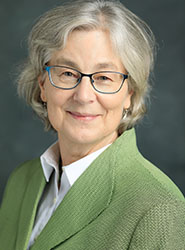
Professor Emerita
Biography
Professor Howes works in late medieval literature and culture, with a focus on Geoffrey Chaucer, the works of the Gawain-poet, pre-modern environments, and the effects of physical movement in narrative. Professor Howes served as the founding director of the Marco Institute of Medieval and Renaissance Studies at UTK, which celebrated its 20-year anniversary in 2021, and has taught medieval and early modern courses for over 30 years. A graduate of Cornell University (English B.A.) and Columbia University’s English and Comparative Literature Program (Ph.D.), Professor Howes retired from teaching at UTK in December 2022.
Education
- B.A., Cornell University
- M.A., Ph.D., Columbia University
Selected Publications
- Ed., with Marie Borroff, Sir Gawain and the Green Knight: A Norton Critical Edition, 2nd edition (NY: Norton, 2022). https://wwnorton.com/books/9780393532463
- “The Troilus Frontispiece and Isabella of Valois.” Medieval Perspectives 35 (2021): 79-103. https://www.academia.edu/87507243/_The_Troilus_Frontispiece_and_Isabella_of_Valois_
- “Teaching the Language of Pearl.” Approaches to Teaching the Middle English Pearl. Ed. Jane Beal and Mark Bradshaw Busbee. (NY: MLA, 2018), 66-71.
- “Chaucer’s Forests, Parks, and Groves.” The Chaucer Review 49.1 (2014): 125-33. https://doi-org.utk.idm.oclc.org/10.5325/chaucerrev.49.1.0125
- “Romancing the City: Margery Kempe in Rome.” Studies in Philology 111.4 (2014): 680-90. https://doi-org.utk.idm.oclc.org/10.1353/sip.2014.0030
- “Use and Reception” [of Medieval Gardens]. A Cultural History of Gardens: In the Medieval Age. Vol. 2. Ed. Michael Leslie. London: Bloomsbury, 2013. 75-100.
- “Inglewood Forest in Two Middle English Romances.” Neophilologus 97.1 (2013): 185-89. https://doi.org/10.1007/s11061-012-9307-3
- “‘Reducing into English’: Translation as Alchemy in the Prologues and Epilogues of William Caxton.” With Sarah McCollum. Notes and Queries 255.3 (2010): 321-25.
- Ed., Place, Space, and Landscape in Medieval Narrative. Tennessee Studies in Literature, vol. 43 (Knoxville: UT Press, 2007).
- “Chaucer’s Criseyde: The Betrayer Betrayed,” Reading Medieval Culture: Essays in Honor of Robert W. Hanning, ed. S.P. Prior and R. Stein (Notre Dame: University of Notre Dame Press, 2005), pp. 324-43.
- “’The Slow Curve of the Footwalker’: Narrative Time and Literary Landscapes in Middle English Poetry.” Soundings: An Interdiscplinary Journal 83.1 (2000): 165-81; rpt. In Inventing Medieval Landscapes: Senses of Place in Western Europe, ed. John Howe and Michael Wolfe (Gainesville: University Press of Flordida, 2002), pp. 192-207.
- Chaucer’s Gardens and the Language of Convention (Gainesville: University Press of Florida, 1997).
- “Theophany in the ‘Miller’s Tale’” (with Frederick M. Biggs), Medium AEvum LXV (1996), 269-79.
- “Cultured Nature in Chaucer’s Early Dream-Poems,” Medieval View of Nature, ed. Joyce E. Salisbury (Garland Press, 1993), 187-200.
- “On the Birth of Margery Kempe’s Last Child,” Modern Philology 90.2 (November 1992), 220-25.